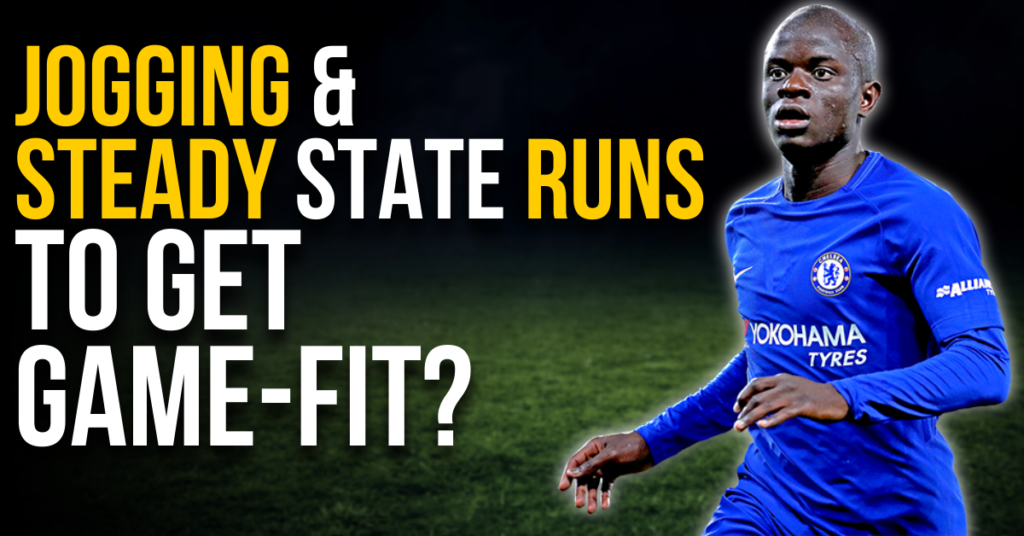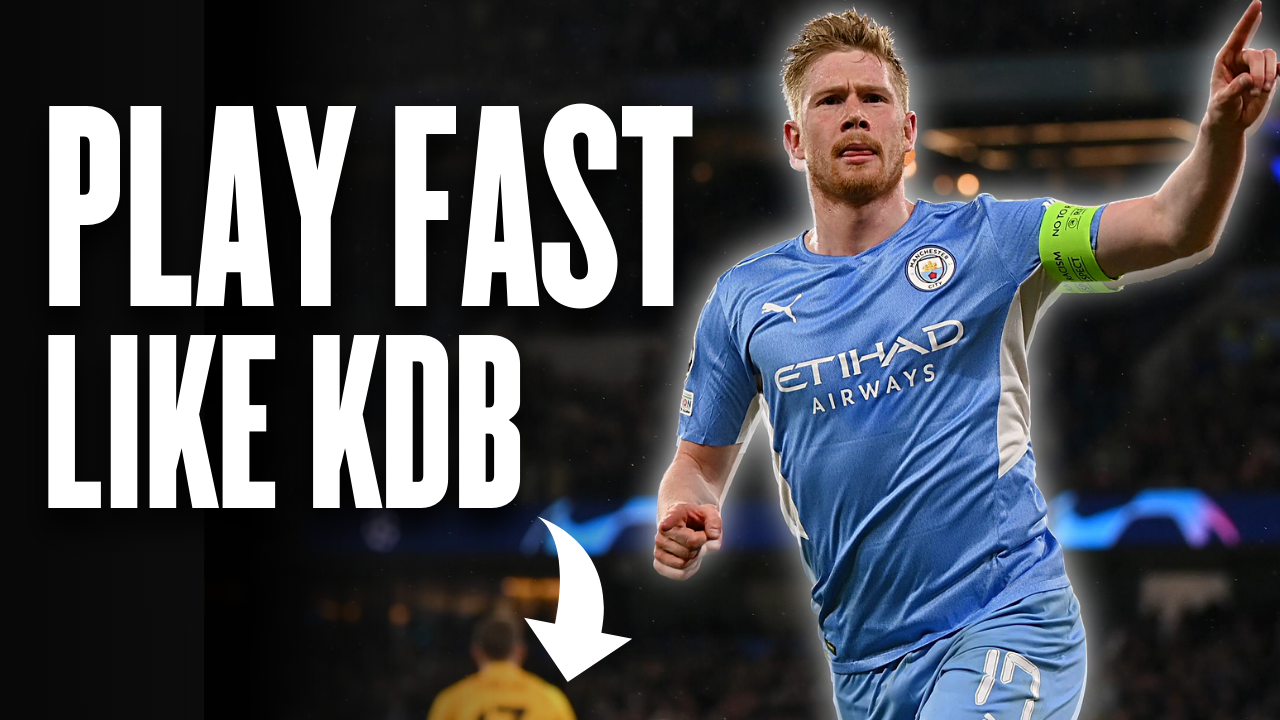
The use of jogging and steady-state cardio runs in football was extremely popular in the past decades. Old-school coaches were using these unorthodox training methods in the hope that their players would acquire the conditioning to play a 90-minute game with ease.
As the years went on and with Sports Science information and data being more accessible to teams and coaches, even at the amateur level, this phenomenon hasn’t stopped but at least it got limited.
Are we heading in the right direction though? Should you jog or run at a steady pace as a footballer for extended periods of time?
BORED OF READING AN ARTICLE? WATCH THE VIDEO VERSION OF IT!
Should I Jog/Run At A Steady Pace As A Footballer To Improve My Stamina?
Jogging and/or steady-state cardio runs are massively overrated by football/soccer players and coaches. Mainly due to the fact that these are only tools that can help you recover and (re-)build your aerobic capacity as a player.
In the modern game, intensity is what plays a major role in terms of conditioning. Therefore, training methods that primarily target your anaerobic system can be deemed as more energy- and time-efficient ways to develop game fitness (given that you have already developed your aerobic system to a certain level).
Why Jogging & Steady State Runs Are Becoming A Problem In Football
On one hand, amateur and youth players who don’t have access to professional coaching staff, perceive steady-state running as the most effective way to improve their stamina and get game-fit.
Although this may be true to some extent, it definitely becomes a limiting factor along the way.
On the other hand, old-school coaches perceive this type of conditioning as effective for various reasons.
So, one could argue that the game they were playing had nothing to do with the modern gameplay. Nowadays, football is much more intense and fast-paced.
Another reason this might be the case is the limited amount of informational resources they had access to. This can oftentimes lead to certain ideas and principles being planted inside your brain, regardless of whether they’re effective or not – you just perceive them as effective because you haven’t been exposed to higher quality training stimuli.
What’s The Difference Between Jogging & Steady State Running In Football?
Let’s start off by saying that jogging and steady-state cardio can be the same but also different things.
Steady-state cardio is *any* form of cardiovascular activity that you perform at a specific and steady pace for the whole duration of the activity. (i.e. jogging, power runs, etc.)

*As an affiliate, I'm earning from qualifying purchases without any extra charges being placed on you.
On the flipside, jogging is a *form* of steady-state cardio that you perform at a pretty low pace.
Why Are Jogging & Steady State Cardio Overrated In Football?
First of all, football has changed. The times when football was played mostly walking around with the ball with little to no pressure are gone!
The Importance Of Your Anaerobic System
The game has become *much* more intense, both on and off the ball.
Players don’t only travel more distance during a game, but moreover, they cover more distance at a high intensity.
Nowadays, the intensity of your actions has become the factor that sets apart the different levels of football. Not volume aka total distance ran.
As a result, the participation of your anaerobic system during a football game increases the higher your playing level.
The Importance Of Your Aerobic System
Of course, we would be blind to not accept the fact that volume and aerobic capacity don’t play an equally important role in sustaining a certain level of peak performance throughout the 90 minutes.
On average a field player covers anywhere between 8 to 12 kilometers during a football match depending on his position. This is something common both in the lower, amateur levels as well as the pro and elite tiers of football.
So, basically, if you wanna be effective and showcase the football you can play with efficiency, you need to have the aerobic capacity to stay active, both on and off the ball, for at least 7 to 8 kilometers, no matter what level you’re playing at, amateur to elite level.
Having said that, if you wanna climb up the ladder of pro football, you won’t only need the aerobic but also the anaerobic capacity of the level you’re aspiring to reach.
You wanna develop your conditioning to get game-fit and be able to sustain a certain level of high performance during the whole match. In order to do that, you need to meet the demands of your level and progressively shoot beyond them!

*As an affiliate, I'm earning from qualifying purchases without any extra charges being placed on you.
If you’re able to travel MORE distance at a HIGH INTENSITY you’ll certainly be more effective as a footballer.
A Practical Example
For example, if an amateur central midfielder covers about 9 kilometers per game, only 300 to 400m of that volume will be high-intensity running.
On the flip side, an elite level central midfielder, like Kevin de Bruyne, or Ngolo Kante can cover the same or higher mileage, but they can sustain a higher level of INTENSITY that enables them to travel MORE high-intensity distance, let’s say 1km.
Having said all of that, we can now understand that VOLUME, or else known as total distance ISN’T the defining quality that sets apart the different levels of football. Although this might be the case for low-level, amateur, and youth football, the demands change the higher you go.
INTENSITY and the ability to cover more high-intensity distance is what really makes the difference between an amateur, a pro, and an elite-level player.
When Should I Jog Or Run At A Steady Pace As A Footballer?
Let’s start off with jogging.
JOGGING
As we’ve mentioned earlier, jogging is a *form* of steady-state cardio that you perform at a really light pace.
Although this form of conditioning is pretty much worthless to a footballer in terms of aerobic and anaerobic adaptations, it can be a really great tool to enhance the recovery process after a hard training session, a workout, or a game.
One of the objectives of post-game recovery is to recover actively and increase blood flow to oxygenate muscle cells, deliver more nutrients to them, as well as flush out waste products much faster.
Jogging for 10 to 20 minutes one or two days after a game can help you actively recover without draining your already drained energy resources.
STEADY-STATE CARDIO RUNS
Now, in terms of steady-state cardio at a higher pace (i.e. power-running), we know that this form of training also has a time and place in the training process.
A player or coach can use this form of conditioning in various instances. All of them have a common goal; establish or reestablish an aerobic capacity that meets the demands of a football game.
This training goal is really common amongst injured players that return to sport, players that have a pretty low training age, as well as the early phases of an off- ore pre-season training block where most players need to gradually ramp up the intensity to lower the risk of injury and smoothly transition into competition.
IS THIS THE TIME TO RETHINK YOUR STRATEGY?
If you have been using steady-state runs for months or even years, I’d highly suggest you rethink your development strategy.
“One of our core values is to provide players with ways to work SMART and avoid the negative consequences the extreme end of hard work can have on your body and mind”
Although steady-state runs might be challenging and hard if you are running at a relatively fast pace or for much time, they definitely aren’t the smartest way to approach the training process for the sole reason that the energy systems these runs are targeting aren’t the ones we wanna develop in order to reach the elite level.
Form Your Aerobic Base – Build Your Anaerobic System With Intensity
As we’ve said, INTENSITY will make the difference the higher you go up the football ranks in comparison to total volume which undoubtedly is the defining quality in lower-tier football where the S&C level of players isn’t quite that big.
It is wise to say that you should build your base aka your aerobic capacity if you haven’t already established it.
Once you have that set at a good level, you will need to PROGRESSIVELY build your neuromuscular and cardiovascular systems’ ability to sustain more high-intensity distance and efforts.
This can be done in a handful of ways which we will go over in another article.
However, to name a few, intensity can be built with;
- High Intensity Intervals
- Power, Speed & Strength Training
- Building more efficient movement patterns
- Playing 11v11s, SSG’s, etc.
Liked this article? Make sure to SHARE it with your teammates and coaches! Also, don’t forget to follow us on INSTAGRAM where we post daily content to help you #levelUP your performance!
REFERENCES
Kubayi, Alliance. (2019). Evaluation of match-running distances covered by soccer players during the UEFA EURO 2016. South African Journal of Sports Medicine. 31. 1-4. 10.17159/2078-516X/2019/v31i1a6127.




